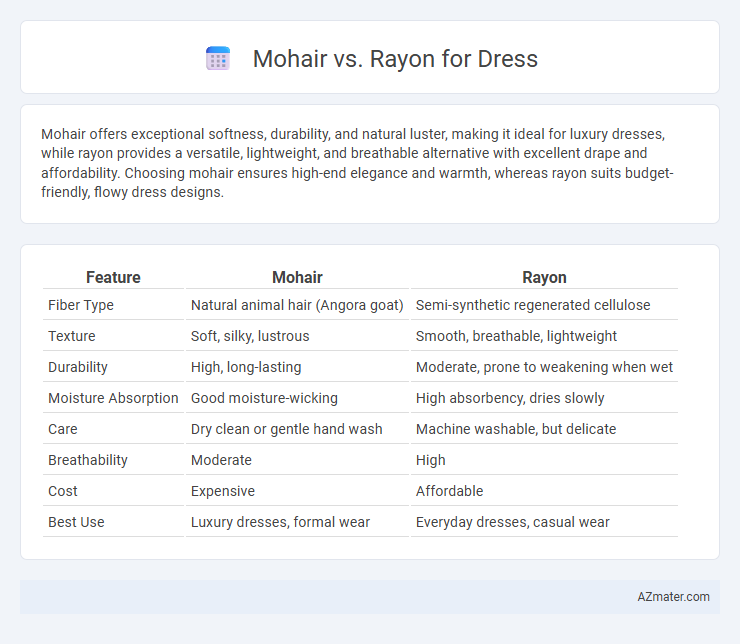Mohair offers exceptional softness, durability, and natural luster, making it ideal for luxury dresses, while rayon provides a versatile, lightweight, and breathable alternative with excellent drape and affordability. Choosing mohair ensures high-end elegance and warmth, whereas rayon suits budget-friendly, flowy dress designs.
Table of Comparison
| Feature | Mohair | Rayon |
|---|---|---|
| Fiber Type | Natural animal hair (Angora goat) | Semi-synthetic regenerated cellulose |
| Texture | Soft, silky, lustrous | Smooth, breathable, lightweight |
| Durability | High, long-lasting | Moderate, prone to weakening when wet |
| Moisture Absorption | Good moisture-wicking | High absorbency, dries slowly |
| Care | Dry clean or gentle hand wash | Machine washable, but delicate |
| Breathability | Moderate | High |
| Cost | Expensive | Affordable |
| Best Use | Luxury dresses, formal wear | Everyday dresses, casual wear |
Introduction to Mohair and Rayon
Mohair, derived from the Angora goat, offers a luxurious, silky texture prized for its durability, insulation, and natural luster in dress fabrics. Rayon, a semi-synthetic fiber made from regenerated cellulose, provides a cost-effective alternative with excellent draping qualities and breathability, often mimicking the feel of natural fibers. Both mohair and rayon serve distinct purposes in dressmaking, balancing elegance, comfort, and fabric performance.
Fiber Origins and Production Processes
Mohair originates from the Angora goat, prized for its silky texture and natural luster, while rayon is a semi-synthetic fiber derived from cellulose found in wood pulp or cotton linters. The production of mohair involves shearing the goats, followed by cleaning, carding, and spinning, preserving its durability and breathability. Rayon undergoes a chemical-intensive process where cellulose is dissolved, regenerated, and spun into fibers, offering a smooth, versatile fabric but with higher environmental impact compared to natural mohair.
Texture and Feel: Mohair vs Rayon
Mohair offers a luxurious, silky texture with a smooth, soft feel and natural sheen, providing excellent warmth and durability for dresses. Rayon, derived from cellulose fibers, delivers a lightweight, breathable fabric with a silky smooth surface but lacks the resilience and insulating properties of mohair. The choice hinges on preferences for mohair's rich texture and warmth versus rayon's cool, fluid drape and affordability.
Durability and Longevity Comparison
Mohair, a natural fiber derived from the Angora goat, exhibits exceptional durability and resilience, making it highly resistant to wear and tear in dress fabrics. Rayon, a semi-synthetic fiber made from regenerated cellulose, tends to have lower durability and is prone to pilling and weakening over time when exposed to moisture and friction. The longevity of mohair dresses is significantly greater, maintaining shape and texture through multiple wears, while rayon dresses often require more delicate care to preserve their appearance.
Breathability and Comfort in Dresses
Mohair offers excellent breathability due to its natural hollow fibers, which allow air circulation and moisture wicking, making it ideal for comfortable dresses in warmer climates. Rayon, a semi-synthetic fiber derived from cellulose, provides a smooth, lightweight texture but tends to retain more moisture, potentially reducing breathability compared to mohair. When prioritizing comfort and airflow in dresses, mohair generally outperforms rayon, ensuring better temperature regulation and a cooler wearing experience.
Aesthetic Appeal and Draping Qualities
Mohair offers a luxurious sheen and natural luster that enhances the aesthetic appeal of dresses, creating an elegant and sophisticated look. Its excellent draping qualities provide a smooth, fluid silhouette that maintains shape while adding volume and texture. Rayon, with its soft, semi-sheer finish, delivers a silky appearance and lightweight drape, making garments flow gracefully but lacking the rich texture and resilience found in mohair fabrics.
Environmental Impact and Sustainability
Mohair, derived from the Angora goat, is a natural fiber known for its biodegradability and renewable sourcing, making it more environmentally sustainable than synthetic alternatives. Rayon, a semi-synthetic fiber made from cellulose, often involves chemical-intensive processing and deforestation risks, raising concerns about its ecological footprint. Choosing mohair dresses supports sustainable fashion through reduced chemical use and lower carbon emissions compared to rayon-based garments.
Care, Maintenance, and Longevity
Mohair dresses require delicate care, including gentle hand washing or dry cleaning to maintain fiber integrity and prevent shedding, ensuring long-lasting softness and luster. Rayon dresses, while breathable and lightweight, demand careful handling as they lose strength when wet, often benefiting from dry cleaning or cold water washing with mild detergent to avoid shrinking or distortion. Mohair typically offers greater durability and longevity compared to rayon, which tends to degrade faster with frequent washing and exposure to sunlight.
Price Differences and Market Availability
Mohair dresses typically come at a higher price point due to the luxurious nature of the fiber, sourced from Angora goats, and its limited production compared to rayon. Rayon dresses are generally more affordable, benefiting from extensive manufacturing processes that allow mass production and widespread market availability. Consumers seeking budget-friendly options will find rayon easily accessible, while mohair remains a premium choice favored for its softness and durability.
Choosing the Right Fabric for Your Dress
Mohair offers a luxurious, durable option with natural sheen and excellent insulation, ideal for elegant, high-end dresses requiring warmth and texture. Rayon provides a lightweight, breathable fabric that mimics silk's smoothness and drapes well, perfect for flowy, affordable dresses suited to warmer climates. Choosing the right fabric depends on factors like desired comfort, appearance, climate, and budget to ensure optimal dress performance and style.

Infographic: Mohair vs Rayon for Dress
 azmater.com
azmater.com